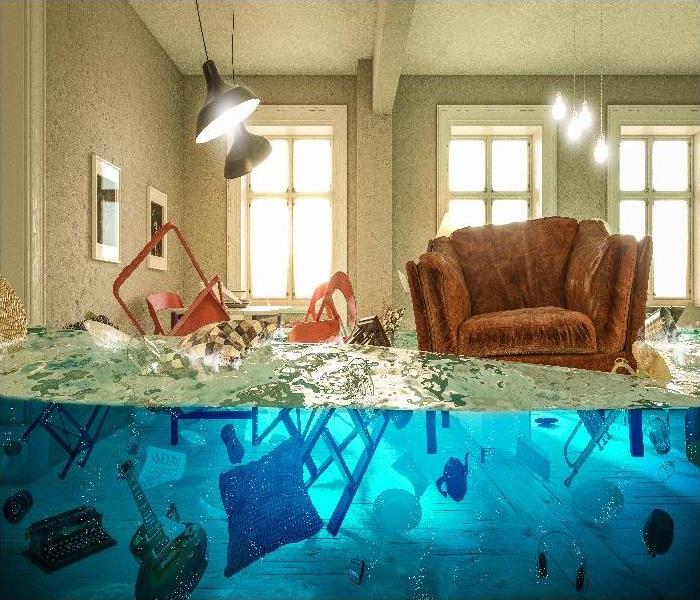How Significant Are the Risks of Water Contamination During the Aftermath of Flood Damage in the Bronx?
8/29/2020 (Permalink)
 The team at SERVPRO of South Bronx has your back when highly-contaminated flood water invades your home.
The team at SERVPRO of South Bronx has your back when highly-contaminated flood water invades your home.
Flood Damage Threatens Your Bronx Home’s Structure and Contents and Might Present Hazards to Your Health and Wellbeing -- You Need the Support of SERVPRO to Weather the Storm
Late summer and fall are prime times for hurricanes and tropical storm systems to move up the Atlantic coast or even sweep across thousands of inland miles connecting the Bronx with the Gulf of Mexico. Once the torrential rains and high winds arrive in the borough, flood damage to your home might not be far behind. The water that rushes in is likely to contain contaminants, requiring a swift, professional response to avoid accelerated structural destruction and health concerns.
Why Are Flood Waters Presumed to Contain Hazardous Substances?
Flood damage in the Bronx is likely to expose your home to a broad range of muck, organic debris, chemicals, sewage, and saltwater if a storm surge occurs. Unlike the relatively clean water that invades your space if a supply line bursts, flooding begins as heavy rain that collects into urban “gully washers,” roiling up and carrying debris into your home from:
• Industrial sites
• Oils and pavement chemicals off roadways and sidewalks
• Sanitary sewer backups when the system becomes overwhelmed
• Saltwater from the East River spreads into neighborhoods
Restoration companies know that the flooding is contaminated by definition, adjusting removal and disposal practices to ensure that applicable regulations on hazardous waste are followed.
How Do Flood Damage Restoration Professionals Approach Contaminated Water Removal?
Upon arrival at your flooded home, the SERVPRO project manager begins with a safety inspection. We need to grasp the extent of the flooding within your home and plan for other hazards such as:
• Overhead structural collapse potential
• Electrical shock
• Slip, trip, and fall risks
• Weakening or other damage to foundations, floors, windows, roofs, or other structures due to winds, rain, or the force of overland flooding
• Confined spaces and trapped water
• Mold growth -- current or potential
What Steps Do Workers Take to Secure and Control the Hazards?
Crew members tarp and board up any roof and exterior damage that otherwise exposes your home to the elements. Our team includes a licensed construction division, an excellent fit if we need to shore up weakened surfaces, sagging ceilings, or bulging walls. The construction of partitions to contain water and debris spread is also standard, preventing infectious substances or chemicals from moving into unaffected areas of your home. As water extraction begins, we may consider calling on our construction crews to carefully plan and implement controlled demolition to assist in the removal of contaminated water:
• Weep holes to release water in ceilings -- punched first near the wall joints and moving toward the center to avoid uncontrollable drainage.
• Cut or drilled holes in drywall near the floor to drain water from building cavities and permit enhanced airflow during the drying phase.
• Flood cuts -- wet drywall is sawn several inches above the flood line between studs for water release and efficient drying.
• Drilled holes in mortar joints in cinder block or other brick-type construction facilitate the removal of water from block cells or behind structures.
• Once flood water-related services complete, our construction team can repair, replace, and rebuild damaged or altered structures.
How Is the Tainted Water Contained During Extraction?
Our truck-mounted units suction water to tanks that can hold more than 100 gallons. Our portable units hold less water than the truck-mounts, but can be drained into holding tanks and reused multiple times to remove flood waters from tight, confined areas.
How Do I Arrange for Lawful Disposal of the Dirty Flood Water?
We are knowledgeable about current disposal requirements in every community we serve. Our crews manage the required paperwork and actual disposal.
Is Removing the Contaminated Flood Water Enough to Protect My Family from Lingering Waste?
Once the bulk of the floodwaters exit through extraction, our crews thoroughly clean affected surfaces. We then apply antimicrobial products to kill any remaining pathogens and inhibit their regeneration, including potential mold growth. The proprietary products used for cleaning and disinfecting are registered for use by the Environmental Protection Agency (EPA).
The team at SERVPRO of South Bronx has your back when highly-contaminated flood water invades your home. Our IICRC-trained crews equipped with the latest products, tools, and technology in flood water removal, containment, cleaning and disinfection, and build-back capability are just a call away at (347) 590-9902.






 24/7 Emergency Service
24/7 Emergency Service